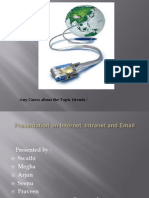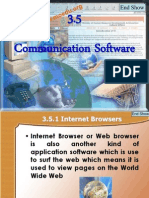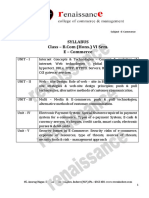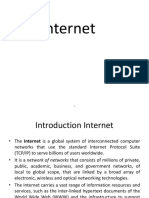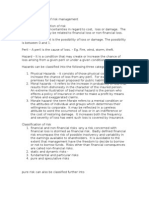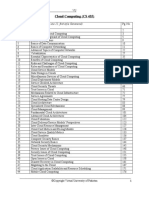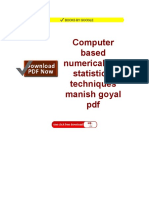Internet Presentation Report Presented by..
Faizan Mulla Ranveer Deokar Manish Kamble Archana Kshirsagar
�Introduction to Internet
The Internet is a communication system that has brought a wealth of information to our fingertips and organized it for our use. In 1967,Vint Cerf & Bobkahn both of whom were role in Internet ting project. They wanted to link different networks together with a host on a second , different network But many problem to overcome. In 1973 Cerf & Kahn's landmark paper outlined the protocols to achieve end to end delivery of data. The idea of a device called A Gateway to serves the intermediary hardware to another. Today, the Internet is certainly the most valuable information resource there is, with over 800 million people using it everyday. When the Internet originally was developed, it was mainly used by governments, scientists, researchers and university teachers. Today, the Internet is used by people in all walks of life, from administrative assistants to CEO's and from blue collar workers to politicians. For these reasons, it's safe to say the Internet is here to stay. The Internet has become practically synonymous with the WorldWide Web. However, to use these terms interchangeably is incorrect. The World-Wide Web (or simply, Web) is a publishing system and is just one of many systems which passes the data over the Internet. The Web is constructed so that visiting sites can
�be accomplished through just a few mouse clicks, and once you have accessed a site you can easily read and watch whats there.
What is the World Wide Web?
The World Wide Web incorporates all the internet services listed above, and more, including the ability to view images, look at video, and hear sound recordings. Using a web browser, you can move from location to location on the internet via text or graphical links called hypertext or hypermedia links. Authors of internet documents can thus allow you to access related sources in a non-hierarchical manner. Web documents are usually created using Hypertext Markup Language, or HTML, and are often referred to as sites or pages. While counts vary, some people put the total number of known web pages in the billions
What is a web browser?
A web browser is a software program which allows you to access and display the information that is on the internet. Netscape Navigator and Microsoft Internet Explorer are the two most commonly used browsers. They allow you to access text, images, videos and sounds (if you have a multimedia computer). Some of the basic features of web browsers are: _Navigation buttons: Allow you to move back, forward, home, etc. _Search & Guide: Includes a selection of some search engines and subject guides endorsed by the browser.
�How do I use email wisely?
Do think before you send a message, especially if it is in any sense critical or damning. Once youve sent it, theres no way of recalling it before it gets there! Do try to read your email at least once a day. People may be relying on contacting you! (From the School machines you can type finger cpp to find out when user cpp last checked their mail but you cant find this out for users on most remote machines.) Do reply to somebody immediately when they email you for the first time. Even if its only a message to say OK I got your message and Im thinking about it, the recipient will know that he/she got through OK and so can stop trying. Furthermore, if YOU email somebody for the first time, then when they reply you should email them back straight away so that they know that THEY got through OK and you are in two-way contact. Do use an address book. This will make it a lot easier to keep track of everybodys address. (When you receive a message from someone new you can use t while looking at the email message in pine and your address book will be automatically updated to include the senders address in it.) Do think carefully before joining email mailing lists. Otherwise you may find yourself swamped with messages.
�Dont send threatening, pornographic, criminal, racist, sexist (or any other -ist for that matter) material using email. Its illegal and you will probably end up in front of both the local magistrate and the Vice-Chancellor! Dont use email to hack other peoples systems. (Again, this sort of thing is treated very seriously nowadays; in the last few years a number of students have been finedBIG MONEY for doing this.)
Dont use email to mess up other users or systems. Brainless examples of this in the past have included (i) sending 100000 messages to somebody (ii) sending messages full of control characters designed to screw up somebodys screen (iii) sending email messages that are so long that they cause the receivers system to crash. Dont get too carried away with email. Sure, its a wonderful invention, but if youre not careful you could spend all day reading and replying to messages!
�Internet Growth Trends
1977: 111 hosts on Internet 1981: 213 hosts 1983: 562 hosts 1984: 1,000 hosts 1986: 5,000 hosts 1987: 10,000 hosts 1989: 100,000 hosts 1992: 1,000,000 hosts
2001: 150 175 million hosts 2002: over 200 million hosts
What does a website normally contain and how fast can I access it?
Most sites start with a home page. When this has loaded, various options are usually High lighted in colours. If you move your mouse over one of these options and a pointing finger appears, then just click the mouse and you will be connected to the link. In this way you can literally traverse the world in a few mouse clicks. The Web is an amazing, mind-boggling source of information. You can find information on almost any topic imaginable if you look for it. I have only been using it regularly for six or so years, yet I really dont know how I would manage without it! I use it for news, reference, business, announcements, games, finding software, job-hunting, . . . .
�What people think about internet?
People have started to realize the importance of Internet in their lives where it is not just a communication mode to email, chat and get information but has become an enabling tool to perform various tasks over Internet like learning, networking, shopping, gaming,
�and expressing themselves in the form of blogs to the extent of establishing a virtual world for themselves
FUTURE OF INTERNET
Single Platform: Internet will (rather is) become most powerful platform for marketing and communication. Brand Reach: More marketing efforts to establish brand and reach millions of customers, a paradigm shift from offline to online! Entertainment: India Film Industry (a.k.a bollywood), will have a huge online presence! Video: Video dedicated sites will increase as broadband increases in India. Cricket: Cricket takes over internet! ( it already is, isnt it?). Localization: Local Search Engines and for enhanced results
Regional Language sites: With over 22 official language, More regional content would be seen soon. Social Media: This will need a separate mention!, With youth driving the internet in india, conversation using social media platforms (social networking,blogs, wiki,podcast etc..) will grow and form a key marketing sector. Mobile Internet: India being one of the nation with highest mobile users, internet penetration is bound to increase and so will mobile marketing
Digital Platforms: IPTV would be the next big thing ( still a long time to see this) but will be the next in internet revolution in India.
Strengths of Internet
Current information Global information Some information only available on the Web Interactive media sources Fast results
�E-Commerce
E commerce is all around us, it has been for years, even long before the Internet. Staring in the 60s, businesses began sharing files and information with each other electronically, the very first form of e commerce. With the Internet, people gained the ability to purchase goods and services from businesses and each other, electronically. All these make up the face of e commerce today. Business-to-business e commerce is the exchange and transfer of files and money between businesses, and as we've mentioned, this began in the 1960s. It took hold in the 80s, though, when one standard was set for electronic transactions that allowed all businesses to connect this way.
Consumer-to-consumer e commerce is when a person goes online and exchanges goods and services with another person. Ebay, for instance, is the original consumer-to-consumer site, with its auctions in which anyone can put up goods for sale to the site's visitors.
�Advantage of ECommerce
Conducting business Cost Profit Customer relations Employees Time
E-business is saving AND selling!
Social Networking Sites
�A social network service focuses on building and reflecting of social networks or social relations among people, e.g., who share interests and/or activities. A social network service essentially consists of a representation of each user (often a profile), his/her social links, and a variety of additional services. Most social network services are web based and provide means for users to interact over the internet, such as e-mail and instant messaging. Although online community services are sometimes considered as a social network service in a broader sense, social network service usually means an individual-centered service whereas online community services are group-centered. Social networking sites allow users share ideas, activities, events, and interests within their individual networks.
The main types of social networking services are those which contain category places (such as former school-year or classmates), means to connect with friends (usually with self-description pages) and a recommendation system linked to trust. Popular methods now combine many of these, with Facebook, Bebo and Twitter widely used worldwide; MySpace and LinkedIn being the most widely used in North America;[1] Nexopia (mostly in Canada);[2] Bebo,[3] Hi5, StudiVZ (mostly in Germany), iWiW (mostly in Hungary), Tuenti (mostly in Spain), Decayenne, Tagged, XING;[4], Badoo[5] and Skyrock in parts of Europe;[6] Orkut and Hi5 in South America and Central America;[7] and Friendster, Mixi, Multiply, Orkut, Wretch, renren and Cyworld in Asia and the Pacific Islands and Orkut and Facebook in India.
�Impact of social networking sites
Youth interest in Social Networking Sites. Overlap with young peoples offline interests hanging out, flirting, trying to build social status,
deciding what image they want to present
Youth activities online
Building own profiles (present self to peers) Visiting other profiles (to see how others present themselves) Commenting on profiles, photos etc (often positive, reciprocated) Important for self-confidence, self-identity, self-esteem (Netherlands)
�Emerging trends in social networks
As the increase in popularity of social networking is on a constant rise[28], new uses for the technology are constantly being observed. At the forefront of emerging trends in social networking sites is the concept of "real time" and "location based." Real time allows users to contribute content, which is then broadcasted as it is being uploaded the concept is similar to live television broadcasts. Twitter set the trend for "real time" services, where users can broadcast to the world what they are doing, or what is on their minds within a 140 character limit. Facebook followed suit with their "Live Feed" where users' activities are streamed as soon as it happens. While Twitter focuses on words, Clixtr, another real time service, focuses on group photo sharing where users can update their photo streams with photos while at an event. Friends and nearby users can contribute their own photos and comments to that event stream, thus contributing to the "real time" aspect of broadcasting photos and comments as it is being uploaded. In the location based social networking space, Foursquare gained popularity as it allowed for users to "check-in" to places that they are frequenting at that moment. Gowalla is another such service which functions in much the same way that Foursquare does, leveraging the GPS in phones to create a location based user experience. Clixtr, though in the real time space, is also a location based social networking site since events created by users are automatically geotagged, and users can view events occurring nearby through the Clixtr iPhone app. Recently, Yelp announced its entrance into the location based social networking space through check-ins with their mobile app; whether or not this becomes detrimental to Foursquare
�or Gowalla is yet to be seen as it is still considered a new space in the internet technology industry.[29]
Some social networking sites
�E- Marketing
Internet marketing, also referred to as imarketing, web marketing, online marketing, or eMarketing, is the marketing of products or services over the Internet. The
�Internet has brought many unique benefits to marketing, one of which being lower costs for the distribution of information and media to a global audience. The interactive nature of Internet marketing, both in terms of providing instant response and eliciting responses make Internet marketing an industry where you can see fast results! Internet marketing ties together creative and technical aspects of the Internet, including design, development, advertising, and sales. By reading this guide, you will become familiar with each of these Internet marketing facets and well on your way to launching a successful site.
What Is An Internet Marketer?
Internet marketing is the business of both advertising and selling goods and services over the Internet. As an Internet marketer yourself, you will be responsible for bringing together potential customers with a service or company that will fit their needs through different Internet avenues. Whether the product being offered is a pair of sneakers or a new car, you are helping others connect with the products they are searching for. With trillions of dollars spent online each year, its clear that the Internet isnt going anywhere and more and more businesses and services will become primarily webbased. With a few clicks, you can often find exactly what youre looking for. The convenience and multitude of information provided by the Internet is incomparable. Thats why you need to be a part of this industry and begin your Internet marketing career.
�Advantages of e Marketing
Cost effectiveness Global reach Interactive response Measurability Personalization Real-time feedback The world of Internet marketing has an extremely low barrier to entry. Do you have a computer? Do you have Internet access? Do you have around $100 to scoop up some domain names and get rolling? Do you have a million dollar idea and the time and passion to implement it? Great, then youre in!
�Uses of internet
E- mail Chatting Shopping Gifting Matrimony E- business E- marketing
Internet Banking etc.
�Size of the Industry
Assessing the size of the Internet is a somewhat difficult proposition, since it is a distributed body, and no complete index of it exists. What we mean by asking how large the Internet is also plays into how we answer the question. Do we mean how many people use the Internet? How many websites are on the Internet? How many bytes of data are contained on the Internet? How many distinct servers operate on the Internet? How much traffic runs through the Internet per second? All of these different metrics could conceivably be used to address the sheer size of the Internet, but all are very different.
Size of the internet is countless. It is immeasurable and uncountable. With a Population of 1.2 billion, 22 states 5 union territories , 22 official languages, GDP of 10% and above, and being worlds largest English speaking nation, India internet population is growing at a fast pace. According to the latest from IMNAI, internet user base grew by a whopping 40% to reach 46 million. Today people realizes that internet is how much useful in our day to day life and how it helps to solve our problems. In todays world internet has become the basic needs of an educated peoples like students, doctors, lawyers, MBAs, bankers etc.
�Impact of Internet
1.
Why the Internet has grown?
The PC is becoming commonplace in many homes and there is a general acceptance that this is a way forward. Analogue phone lines are being replaced by faster digital lines (ISDN). Even faster high-speed digital connections will soon be delivered to households, offering a whole day connection to the Net. Many countries around the world are developing in communication technology via satellite, wireless and cable to enhance worldwide Internet access. Access to the Internet and its services have already become available through the use of digital TVs and mobile phones. The use of the Internet by many business, organisations and the general public has led to a rapid increase in the number of sites.
2. The Internet and the way we work
Information technology has had an impact on the way we work for quite some time, but the Internet has now added electronic mail (email), teleworking and video conferencing to the workplace. Teleworking
�The ability to work from home by means of a PC or laptop and since some communications link are increasing, and there are a number of benefits to the employer: Office running costs and overheads (rates, electricity, heating etc.) can be reduced, which in turn may reduce the need for office space. Travel-related problems may be reduced. It may tempt better staff to come and work for the company. However, employers need to be able to trust their staff and be prepared to have less direct control over them.
Benefits for the employee include: You can work from the comfort of your own home. There is no time wasted travelling and no travel costs. It enables you to work around the needs of your family and/or children, giving you greater flexibility. It is more convenient - you can plan the working day to suit you, which could help reduce stress levels.
Video conferencing Video conferencing means using computers to provide a videolink between two or more people. Instead of just talking to someone by telephone, you are able to see them as well. Benefits include: Meetings can take place without leaving the office. Travel costs and the time taken to travel can be reduced significantly. Meetings can be called instantly worldwide with little notice. Delegates can still attend meetings even if they are physically unable to.
�3. How the Internet is changing our lifestyle
Home shopping Home shopping options are many and varied and changing all the time. Most major supermarkets are now on-line, offering home delivery of goods and increasingly, the major high street stores are also competing for on-line trading. The Internet lends itself to shops selling goods which are easily portable, such as CDs and books.
The benefits of home shopping to the customer include: You can avoid long queues, save time and shop from the comfort of your own home. You do not have to travel into city centres or pay for car parking costs. You can shop around for the best prices and shop abroad for cheaper goods. It can offer the customer a wider range of shopping, 24 hours a day all year round. People who are house-bound have the ability to shop and have goods delivered.
Benefits to the company include: It opens the market to customers nationally and internationally.
�It enables smaller companies to compete with larger companies. There may be a possible reduction in staffing and/or shopping outlets, thereby reducing costs. You can offer 24 hour shopping at minimum cost.
4. The future
Increased speed of access combined with digital, satellite and wireless technologies will see Internet use and the resources on offer continue to expand. In the home digital TV offering Internet access will enable home viewers to shop, bank, play games and send email. At work digital phone lines will offer companies high-speed communication enabling business to be conducted quickly, efficiently and with reduced costs. Access to video conference links will become commonplace. Wireless technology (WAP) will support mobile phones offering hand-held Internet access. Pocket-sized units will link email to weather, news, travel, entertainment listings and holiday information. As connection speeds improve, banking, shopping and video conferencing will take place on the move, in the car on the bus, train or plane. On the road new systems will be able to pinpoint your car on an onboard computer which will provide access to road and traffic information. Car phones will link to the Internet allowing drivers to check their email.
Impact on other media consumption
Tv viewers has decreased by 23%
�Magazine readers has decreased by 20% News paper readers decreased by 15% Radio listeners decreased by 9%






